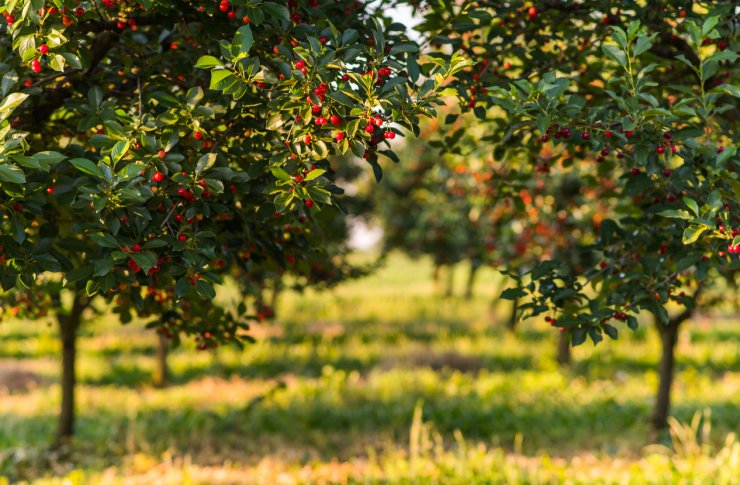
Ever stared longingly at a neighbor’s cherry tree bursting with blossoms or dripping with fruit and thought, “I want that”? I get it! Cherry trees are the showstoppers of the spring garden and reward you with either gorgeous flowers or delicious fruit (or both if you’re lucky). But here’s the thing about cherry trees – they’re surprisingly picky about where they’ll happily grow.
Let’s dive into finding your perfect cherry match based on your USDA growing zone. I’ll help you navigate the sometimes confusing world of cherry varieties, chill hours, and pollination requirements so you can choose a tree that’ll actually thrive in your garden. Because nothing’s more disappointing than investing years in a tree that’s doomed from the start!
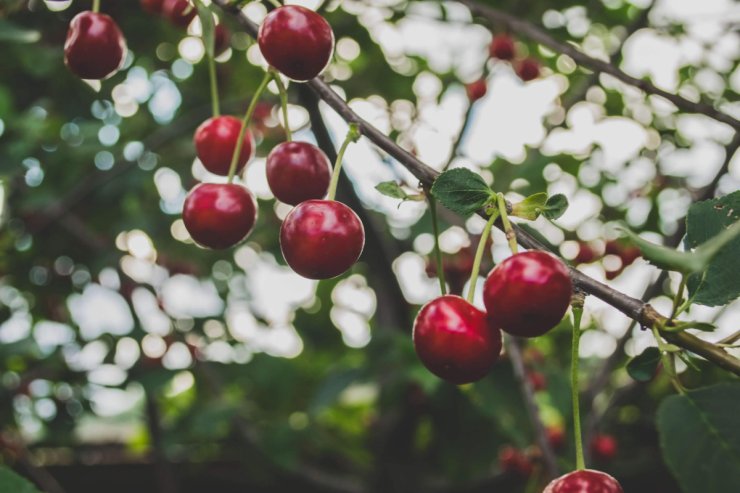
Understanding Cherry Trees: The Basics
Before we match you with your cherry soulmate, let’s cover some quick basics:
Sweet vs. Sour Cherries: Sweet cherries are what you typically find in the grocery store – think Bing cherries that you eat fresh. Sour cherries (like Montmorency) are primarily for cooking and preserving. They have different growing requirements, with sour cherries generally being more cold-hardy and adaptable.
Chill Hours: This is the number of hours below 45°F that a tree needs during winter dormancy. Get this wrong, and your tree might bloom at weird times or not produce fruit at all. It’s arguably the most important factor in cherry success!
Pollination Requirements: Some cherry trees are self-fertile (they don’t need a pollination partner), while others need a compatible variety nearby to produce fruit. Know this before you commit, especially if you have limited space.
Now let’s find your perfect match based on your growing zone!
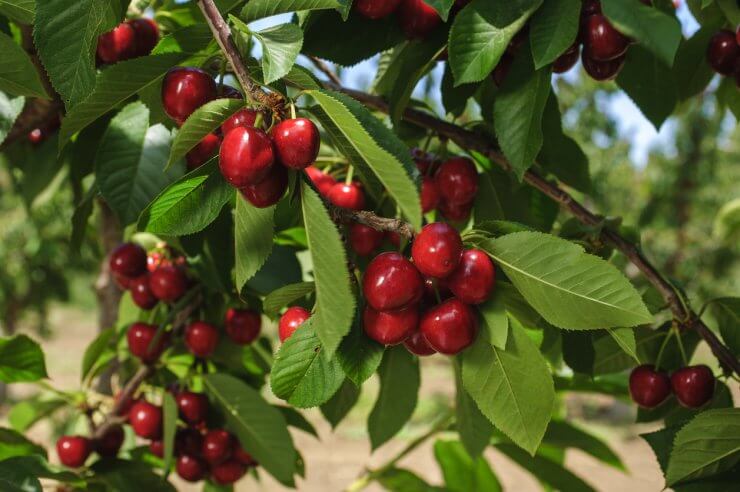
Cherry Trees for Cold Climates: USDA Zones 4-5
If you’re gardening where winters feel endless and spring is a brief moment between snow and mosquito season, you need tough cherry trees that can handle the cold.
Best Sweet Cherry Varieties for Zones 4-5:
Black Gold: This newcomer is a game-changer for cold climate gardeners. Self-fertile, late-blooming (which helps avoid spring frost damage), and hardy to zone 4. The dark fruits have excellent flavor and resist cracking.
White Gold: The sister variety to Black Gold with similar cold hardiness but yellow fruit with a red blush. Self-fertile and disease resistant.
Kristin: A dark, sweet cherry that ripens later in the season and shows excellent cold hardiness down to -20°F.
Stella: An old reliable self-fertile variety that’s hardy to zone 5. Great for gardeners with limited space who can only fit one tree.
Best Sour Cherry Varieties for Zones 4-5:
Meteor: A dwarf sour cherry that stays under 10 feet tall – perfect for smaller gardens! Extremely cold hardy to zone 4 and self-fertile.
Northstar: Another compact option (8-10 feet) with excellent cold tolerance. Self-fertile with dark red fruit perfect for pies and preserves.
Montmorency: The classic sour pie cherry, hardy to zone 4 and self-fertile. Produces abundantly once established.
Carmine Jewel: Part of the Romance series of bush cherries developed for extreme cold. These grow as bushes rather than trees and can handle temperatures down to -40°F!
Planting Tips for Cold Zones:
- Plant in spring rather than fall to give trees time to establish before harsh winter
- Choose a site with protection from strong winter winds
- Mulch heavily but keep mulch away from the trunk
- Consider using white tree guards on young trees to prevent winter sun scald
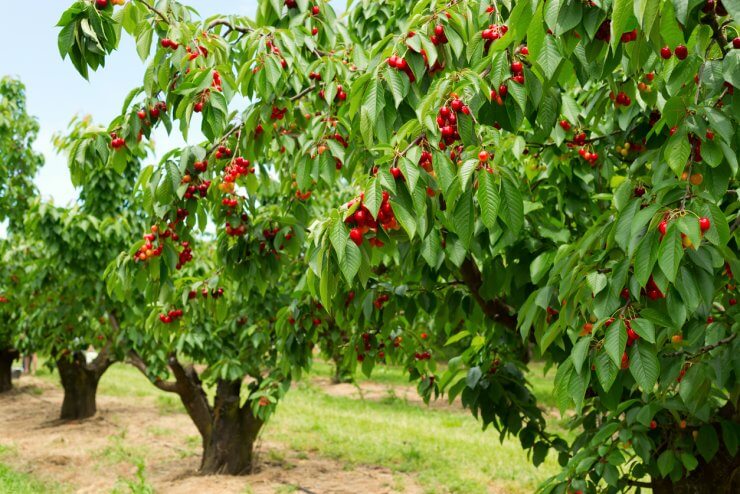
Cherry Trees for Middle Zones: USDA Zones 6-7
These transitional zones offer a sweet spot for cherry growing, with enough winter chill for most varieties but milder conditions than the far north.
Best Sweet Cherry Varieties for Zones 6-7:
Bing: The classic sweet cherry with firm, juicy, dark fruits. Needs a pollinator like Stella or Black Tartarian.
Rainier: Those gorgeous yellow cherries with a red blush command premium prices at markets. Needs a pollinator.
Black Tartarian: An heirloom variety with intense flavor. Great pollinator for other sweet cherries.
Lapins: Self-fertile sweet cherry similar to Bing but without needing a pollinator. Canadian-bred for good disease resistance.
Royal Ann (Napoleon): Firm, crackling pale yellow fruit with red blush. Classic for making maraschino cherries.
Best Sour Cherry Varieties for Zones 6-7:
English Morello: Late-ripening, dark-juiced sour cherry that performs well even in partial shade. Self-fertile.
Balaton: A newer tart cherry from Hungary that’s sweeter than Montmorency with darker juice. Self-fertile.
Early Richmond: Early-ripening tart cherry that’s been grown since the 1600s. Adaptable to various soil conditions.
Planting Tips for Middle Zones:
- These zones can experience late spring frosts – site trees on higher ground if possible
- Sweet cherries appreciate afternoon shade in the warmer end of zone 7
- South-facing slopes help protect blooms from late freezes
- Consider planting flowering cherries and fruiting cherries for extended seasonal interest
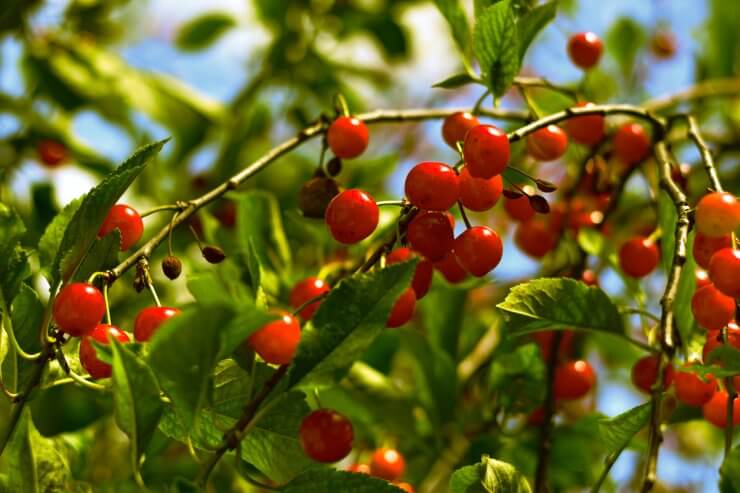
Cherry Trees for Warm Climates: USDA Zones 8-10
Conventional wisdom says cherry trees won’t fruit in warm climates due to insufficient chill hours. While it’s true that most cherries perform poorly in zones 8-10, plant breeders have developed some exciting low-chill varieties that defy expectations!
Best Sweet Cherry Varieties for Zones 8-10:
Minnie Royal: Needs only 200-300 chill hours, making it suitable for zone 8 and even warmer areas. Pair with Royal Lee for pollination.
Royal Lee: The pollination partner for Minnie Royal, also requiring just 200-300 chill hours.
Royal Crimson: A newer self-fertile sweet cherry needing only 200-300 chill hours.
Black Pearl: Self-fertile sweet cherry with good adaptation to zone 8, needs 500 chill hours.
Best Sour Cherry Varieties for Zones 8-10:
Unfortunately, sour cherries generally require more chill hours than sweet cherries and aren’t recommended for zones warmer than zone 8. However, some gardeners in zone 8 report success with:
Nanking Cherry (Prunus tomentosa): Actually a bush cherry that’s more heat tolerant than true sour cherries.
Flowering Cherries for Zones 8-10:
If fruit production isn’t possible in your climate, consider ornamental flowering cherries for their spectacular spring display:
Okame: Early blooming with carmine-pink flowers, adaptable to zones 6-9.
Kwanzan: Dramatic double pink blooms on a vase-shaped tree, adaptable to zone 8.
Yoshino: The famous Washington D.C. cherry blossom variety, with almond-scented single white flowers.
Taiwan Cherry (Prunus campanulata): Can grow in zones 8-10, with deep pink bell-shaped flowers.
Planting Tips for Warm Zones:
- Plant trees where they receive morning sun but afternoon shade to protect from intense heat
- Ensure excellent drainage – cherries hate wet feet, especially in warmer climates
- Consider growing in large containers that can be moved to cooler spots during dormancy
- Apply and maintain a thick layer of mulch to keep soil temperatures cooler
- Be vigilant about watering during establishment, especially during hot spells
Care Tips for All Cherry Trees, Regardless of Zone
- Soil Matters: Cherry trees prefer well-draining, fertile soil with a pH between 6.0-7.0. If your soil is heavy clay, consider planting on mounds or in raised beds.
- Spacing: Sweet cherries on standard rootstock need about 20-25 feet between trees. Dwarf varieties may need just 8-10 feet. Sour cherries typically need 15-18 feet spacing.
- Pruning: Despite some differences between sweet and sour varieties, all cherries benefit from an open center pruning style that allows light penetration.
- Pests and Disease: Birds love cherries as much as we do! Bird netting may be essential. Cherry trees can also suffer from common issues like black knot, cherry leaf spot, and brown rot. Choose resistant varieties when possible.
- Harvesting Timeline: After planting, sweet cherries typically begin bearing fruit in 4-7 years, while sour cherries may produce in 3-5 years, depending on the size of tree when planted.
Finding the right cherry tree for your climate is the critical first step to success. Remember, it’s not just about survival – it’s about a tree that can thrive and produce consistently in your specific conditions.
- For zones 4-5, focus on cold-hardy varieties and provide winter protection.
- For zones 6-7, you’re in cherry heaven with the widest selection of both sweet and sour varieties.
- For zones 8-10, look specifically for low-chill varieties or consider beautiful flowering cherries if fruit production isn’t possible.
Whatever your zone, few spring sights can match a cherry tree in full bloom, and few summer treats can beat a bowl of fresh-picked cherries from your own garden. Choose wisely, plant properly, and you’ll be rewarded with decades of beauty and bounty!
What cherry varieties have you tried in your garden? Have you found any that perform particularly well in challenging zones? I’d love to hear about your experiences!


 Previous
Previous

